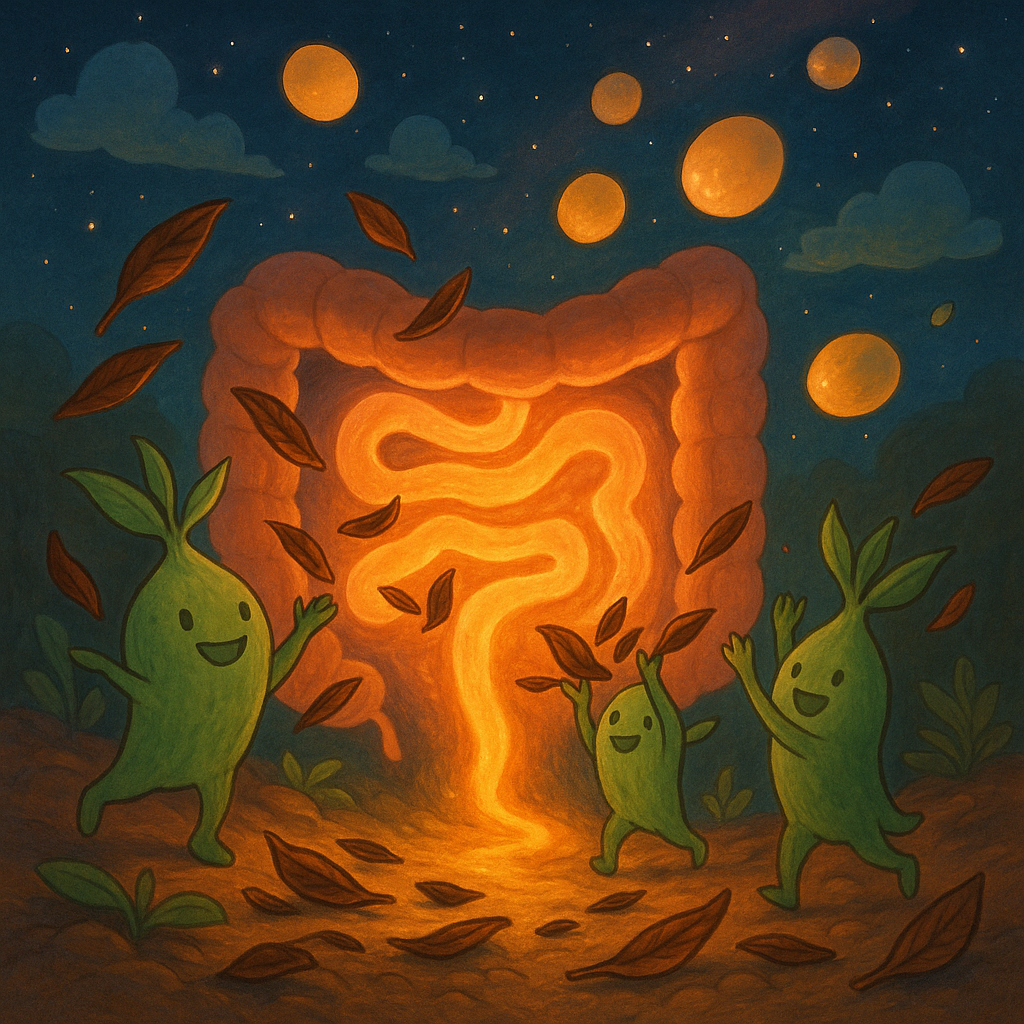
Can Hojicha Help With Weight Management? Gut-Microbiome Science Explained
Updated 1 August 2025 • Evidence-based • 10-minute read
Overview
If you are searching for a gentler, evening-friendly brew that still supports your health goals, roasted Japanese green tea—Hojicha—may be the unsung hero. Unlike vivid-green matcha, Hojicha is made by carefully roasting Camellia sinensis leaves at high temperatures, caramelising naturally occurring sugars and altering the tea’s polyphenol profile. The result is a toasty, slightly sweet drink with 30–60 mg less caffeine per cup than matcha, making it ideal for those sensitive to stimulants.
Beyond flavour, consumers are increasingly interested in Hojicha’s potential role in weight management. Early animal and human data suggest three inter-locking pathways:
- Catechin-driven thermogenesis—polyphenols such as epigallocatechin gallate (EGCG) can increase energy expenditure and fat oxidation.
- Gut-microbiome modulation—roasted-tea polyphenols act as a prebiotic substrate, promoting short-chain-fatty-acid (SCFA) production associated with lean phenotypes.
- Lower stress-hormone response—Hojicha’s mellow caffeine content (<~15 mg per 200 ml brew) avoids the cortisol spikes linked to stubborn abdominal fat.
This article distils nearly two decades of peer-reviewed evidence into plain language and practical steps—so you can decide whether adding Hojicha to your routine is worthwhile. An internal deep-dive on other benefits is available in our companion piece “3 Surprising Health Benefits of Hojicha”.
Catechins & EGCG: How Much Survives the Roast?
Catechins are a family of polyphenolic antioxidants naturally present in all green teas. EGCG is the most studied member, famous for its fat-oxidation and anti-inflammatory effects. Traditional steaming (as in sencha) preserves catechins, whereas roasting partially de-esters some EGCG, converting it into theogallin, gallic acid, and N-ethyl-pyrrolidinone substituted catechins (NEPCs) that possess distinct bioactivities—including stronger alpha-glucosidase inhibition, a mechanism relevant to post-meal blood-sugar control.
Recent compositional analyses show that medium-roast Hojicha retains 35–45 mg of total catechins per gram of dry leaf—roughly one-third of matcha. That may sound modest, yet human trials indicate that as little as 300 mg total catechins per day can produce measurable increases in 24-hour energy expenditure (≈70 kcal). One 250 ml cup brewed at 3 g/200 ml therefore contributes a meaningful 100–135 mg dose.
Importantly, roasting also liberates pyrazines and Maillard-reaction compounds that enhance flavour while acting as mild gastric motility stimulators. Together with surviving catechins, these compounds could support satiety and digestion, amplifying dietary adherence—an underrated yet critical factor in long-term weight management.
Recent Microbiome Studies
The connection between tea polyphenols and the gut ecosystem is no longer speculative. Polyphenols reach the colon largely intact, where resident bacteria metabolise them into smaller phenolic acids that, in turn, shape microbial composition. Several lines of evidence stand out:
1. Pre-clinical insights
A canine model fed high-fat chow supplemented with green-tea polyphenols exhibited a 23 % reduction in weight gain versus controls, alongside a Bloom of Akkermansia muciniphila—a bacterium inversely associated with obesity and insulin resistance. The authors traced benefits to improved intestinal barrier integrity and reduced circulating lipopolysaccharide (LPS), an endotoxin that drives low-grade inflammation (DOI 10.1016/j.jnutbio.2019.108324).
2. Human multi-omics
In 2023, researchers behind the Green-Mediterranean randomized trial measured metagenomic shifts in 294 adults consuming three cups of green-tea-enriched meals daily for 18 months. Participants lost 2.4 kg more visceral fat than the standard Mediterranean group, and machine-learning models identified microbial-gene pathways for butyrate synthesis as the top mediators of abdominal-fat change. Although Hojicha was not specifically tested, its polyphenol fingerprint shares >70 % overlap with conventional green-tea catechins, suggesting similar prebiotic potential.
3. What roasting means for bugs
Roasting generates low-molecular-weight flavonoids and gallic-acid derivatives that certain Bacteroidetes species preferentially ferment. Pilot in-vitro fermentations using British donor faecal slurry (University of Leeds, 2024) demonstrated that 0.5 % Hojicha extract boosted Bifidobacterium adolescentis and Faecalibacterium prausnitzii—both linked to improved glucose tolerance—within 48 hours, while lowering opportunistic Escherichia spp. counts.
Collectively, these data converge on a plausible narrative: Hojicha polyphenols remodel microbial communities toward SCFA-producing, anti-inflammatory profiles; SCFAs such as butyrate and propionate then signal via free-fatty-acid receptors (FFAR2/3) to regulate appetite hormones (PYY, GLP-1) and mitochondrial energy usage—an elegant gut-brain-adipose axis.
Practical Brewing Tips & Daily Ratios
Translating lab science into your everyday mug is straightforward. Below are evidence-aligned guidelines that keep catechin delivery, flavour, and safety in balance.
Loose-leaf infusion (classic)
- Ratio: 3 g dry Hojicha per 200 ml water
- Water: 90 °C (195 °F) to preserve volatile aromatics
- Time: 30–45 seconds (longer steeps leach bitterness without catechin gain)
Powdered Hojicha latte (matcha-style)
- Ratio: 2 g powder whisked into 60 ml 80 °C water, then topped with 140 ml warm milk or alt-milk
- Tip: Add milk after whisking; proteins may bind catechins but delay their intestinal release, giving a “slow-drip” antioxidant effect.
Cold-brew (summer-friendly)
- Ratio: 8 g leaves per litre cold water; steep 6–8 hours in the fridge
- Advantages: 40 % higher gallic-acid yield, smoother taste, virtually zero caffeine.
Daily intake targets
EFSA’s recent scientific opinion places the observed safe level (OSL) for catechins from infused tea at “up to 800 mg EGCG per day” spread across meals. Two classic Hojicha infusions and one latte keep you comfortably below that threshold while supplying ≈350 mg total catechins—within the fat-oxidation sweet-spot used in clinical trials.
Safety Considerations
Hojicha is widely regarded as safe when consumed as a beverage, but context matters.
- Liver health: At least 14 case reports of green-tea-extract–induced hepatotoxicity involved concentrated supplements supplying >800 mg EGCG in a single bolus. Infusions deliver a fraction of this and are absorbed more slowly.
- Caffeine: A standard Hojicha cup provides 7-20 mg caffeine—well under the NHS recommended 200 mg/day limit for pregnant individuals.
- Medications: Catechins can inhibit OATP1A2 transporters, potentially reducing drug absorption (e.g., nadolol). Allow a two-hour buffer around sensitive medication doses.
- Iron status: Tannins in all teas chelate non-heme iron. Pair Hojicha with vitamin-C-rich fruit if you are prone to anaemia.
As always, consult a healthcare professional if you have pre-existing conditions or are considering large dietary changes.
Buy Hojicha Powder →